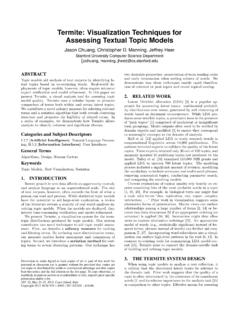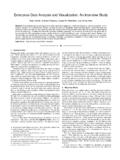Transcription of Narrative Visualization: Telling Stories with Data
1 Narrative Visualization: Telling Stories with DataEdward Segel and Jeffrey HeerAbstract Data visualization is regularly promoted for its ability to reveal Stories within data, yet these data Stories differ in importantways from traditional forms of storytelling. Storytellers, especially online journalists, have increasingly been integrating visualizationsinto their narratives, in some cases allowing the visualization to function in place of a written story. In this paper, we systematicallyreview the design space of this emerging class of visualizations.
2 Drawing on case studies from news media to visualization research,we identify distinct genres of Narrative visualization. We characterize these design differences, together with interactivity and mes-saging, in terms of the balance between the Narrative flow intended by the author (imposed by graphical elements and the interface)and story discovery on the part of the reader (often through interactive exploration). Our framework suggests design strategies fornarrative visualization, including promising under-explored approaches to journalistic storytelling and educational Terms Narrative visualization, storytelling, design methods, case study, journalism, social data INTRODUCTIONIn recent years, many have commented on the storytelling potentialof data visualization.
3 News organizations including the New YorkTimes, Washington Post, and the Guardian regularly incorporate dy-namic graphics into their journalism. Politicians, activists, and televi-sion reporters use interactive visualizations as a backdrop for storiesabout global health and economics [10] and election results [9]. A re-cent feature in The Economist [6] explores the proliferation of digitaldata and notes that visualization designers are melding the skills ofcomputer science, statistics, artistic design and storytelling.
4 Static visualizations have long been used to support storytelling,usually in the form of diagrams and charts embedded in a larger bodyof text. In this format, the text conveys the story, and the image typ-ically provides supporting evidence or related details. An emergingclass of visualizations attempts to combine narratives with interactivegraphics. Storytellers, especially online journalists, are increasinglyintegrating complex visualizations into their successful data Stories requires a diverse set of and Page [12] note that effective story- Telling require[s]skills like those familiar to movie directors, beyond a technical expert sknowledge of computer engineering and science.
5 While techniquesfrom oration, prose, comic books, video games, and film productionare applicable to Narrative visualization, we should also expect thisemerging medium to possess unique attributes. Data Stories differ inimportant ways from traditional storytelling. Stories in text and filmtypically present a set of events in a tightly controlled tours through visualized data similarly can be organized in alinear sequence, they can also be interactive, inviting verification, newquestions, and alternative , most sophisticated visualization tools focus on data ex-ploration and analysis.
6 Applications such as spreadsheets and visual-ization tools support an array of analysis routines and visual encod-ings, but beyond exporting images for presentation typically providescant support for crafting Stories with analysis results. As such, theyprovide powerful vehicles for discovering Stories , but do little to aidnarrative communication of these findings to others. As tools matureand more richly integrate with the web ( , Many Eyes [25], TableauPublic [22], GeoTime Stories [8]), they are enabling the publicationof dynamic graphics with variably constrained levels of remains an open question how the design of such tools might beevolved to support richer and more diverse forms of storytelling.
7 The authors are with Stanford University, Stanford, CA :{esegel, received 31 March 2010; accepted 1 August 2010; posted online24 October 2010; mailed on 16 October information on obtaining reprints of this article, please sendemail to: this paper, we investigate the design of Narrative visualizationsand identify techniques for Telling Stories with data graphics. We takean empirical approach, analyzing visualizations from online journal-ism, blogs, instructional videos, and visualization research. After re-viewing related work, we share five selected case studies which high-light varied design strategies and illustrate our analytic approach.}
8 Wethen formulate a design space constructed from an analysis of 58 ex-amples. Our analysis identifies salient dimensions of visual story- Telling , including how graphical techniques and interactivity can en-force various levels of structure and Narrative flow. We describe sevengenres of Narrative visualization: magazine style, annotated chart, par-titioned poster, flow chart, comic strip, slide show, and video. Thesegenres can be combined with interactivity and messaging to producevarying balances of author-driven and reader-driven experiences.
9 Fi-nally, we discuss the implications of our framework, noting recurringdesign strategies, promising yet under-utilized approaches to integrat-ing visualization with other media, and the potential for improved userinterfaces for crafting data Stories . By focusing on the graphical andinteractive elements of Narrative visualization, our approach gives lessattention to the cognitive and emotional experience of the reader. Werecognize the importance of these elements, however, and describe di-rections for future reader-centric research in our RELATEDWORKS torytelling and visual expression are integral parts of human culture;storytelling has even been referred to as the world s second-oldestprofession [12].
10 Without summarizing millennia of achievement, wedescribe a few of the key concepts informing Narrative Narrative StructureThe Oxford English Dictionary definesnarrativeas an account of aseries of events, facts, etc., given in order and with the establishing ofconnections between them. Central to this definition is the notion ofa chain of causally related events. Stories of this form often have abeginning, middle, and end [3, 24]: an introduction to the situation, aseries of events often involving tension or conflict, and a ancient times, people have tried to understand and formalizethe elements of storytelling.


